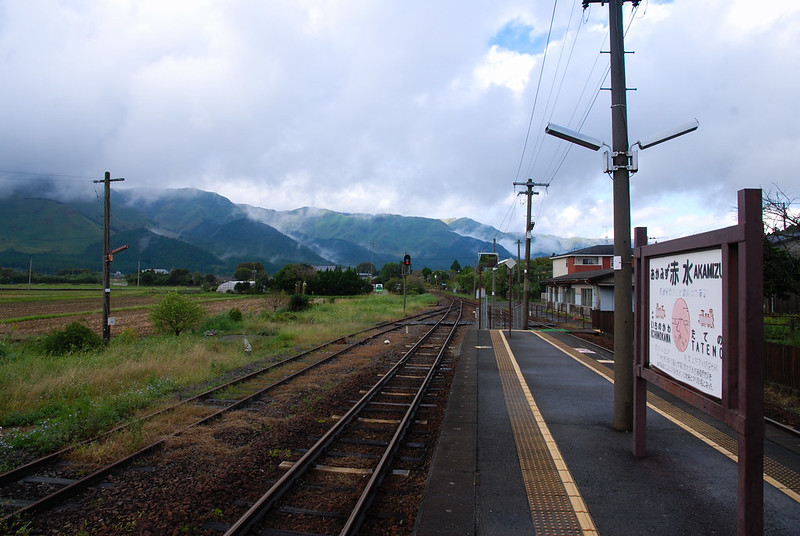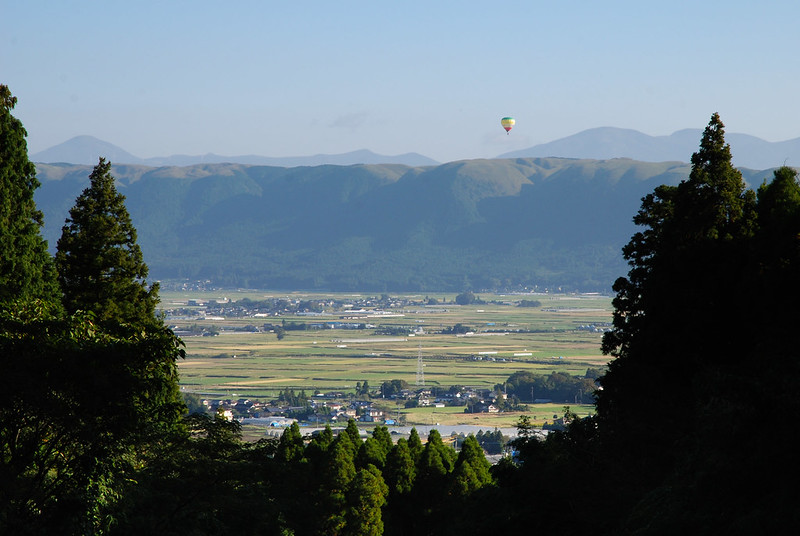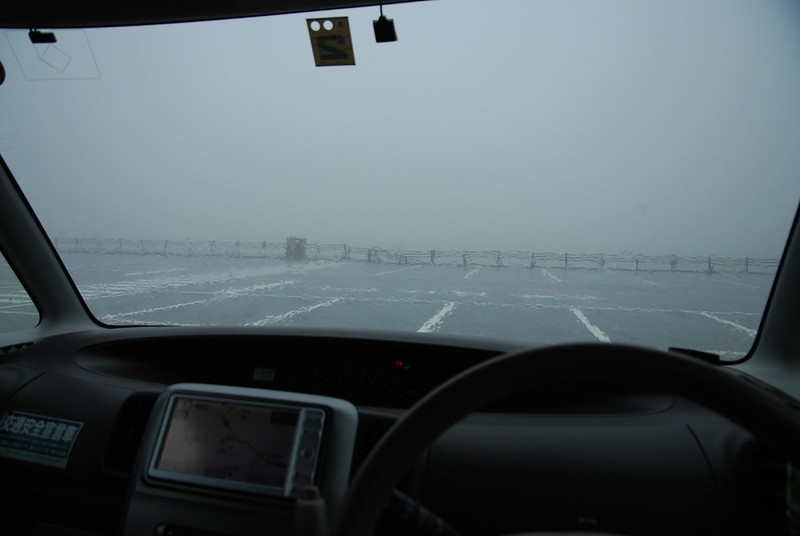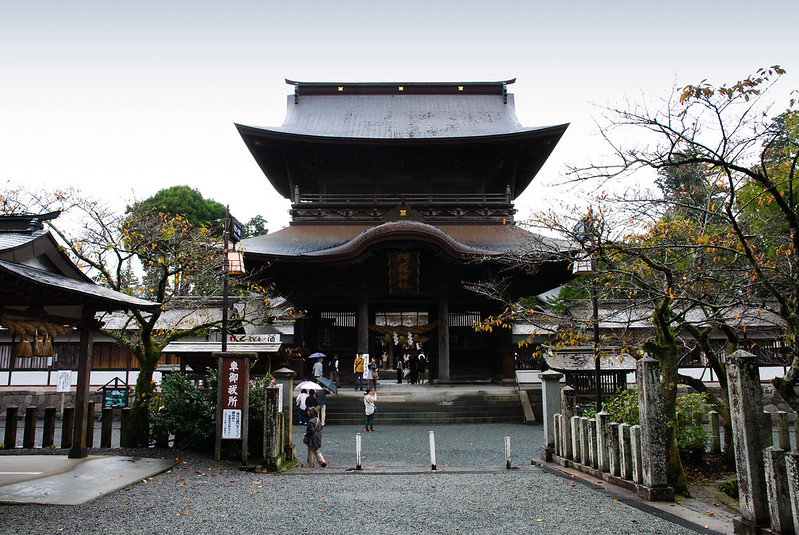My last must-see stop in Kyushu was the area around Aso-San, a massive volcano in the middle of the island. To get from Aoshima (via Miyazaki) to there involves passing through Beppu – take a limited express up via Oita.
Beppu: All about the Onsen
I’ll be absolutely honest: if you don’t like onsen*, you can probably skip Beppu entirely. The whole city is packed with them – including one maybe 200m from the station – and not much else. Compared to other onsen-powered towns, though (say, Kinosaki), Beppu isn’t particularly scenic – it’s just a perfectly nice town that happens to have dozens of springs, and many of them are inside private inns and hotels.
Armed with a map (get one in the station) and a half-grasp of Japanese, though, I managed to find my way to Takegawara Onsen – a really venerable old bathhouse where, for a few hundred yen, I got to experience one of the hottest baths I’ve ever come across. It’s well worth a walk, even if you just stopped in town for an hour or two to do so.
To get to the other onsen north of the town, though, you’ll need a car or bus – it was getting late in the day, so I took a train across to Kamegawa station, just east of the main town. This area feels less busy, and generally more pleasant, than the city centre, and I took a dip at Hamada Onsen – a great back-to-basics place, filled with locals.
If I went through Beppu again, I’d probably stop just for the day. This time I stayed one night at the Sea Wave Hotel (right by the station, friendly business-y place, recommended for the price).
Early the next day, I moved on to Aso-San.
Aso-San: Volcanos in the Mist
The small town of Aso is served by occasional limited express trains as they pass across the island. It sits inside the enormous caldera of the Aso-San group of volcanos – active, and the largest in Japan. I’d been warned that visiting could be complicated if the volcanoes were emitting a particularly large amount of dangerous gas (yikes) – what I hadn’t bargained on was bad weather instead.
Rather like Tazawako, my planning for Aso was hamstrung by car rental companies. There’s a rental pickup right by the station (Ekiren), but to use it you have to book in advance – I tried to book in advance at the Ekiren branch in Beppu, to be told that I had to call the Aso branch, to then be told by the Aso branch that one day in advance wasn’t enough. So that’s handy.
Fortunately, there’s a trick. If you want to rent a car at Aso without booking, show up at Aso then take a local train to Akamizu – exit the station, look down the main road to the right, and there’s a Toyota Rent-a-Car. Once again, Toyo-ren saved the day. You’ll need an international permit and to speak a bit of Japanese (and/or crazy skills at sign language, maybe).
And so, armed with a rented Kei-car, I took on the volcano.
The photo above shows the stunning view from right up almost as far as you’re allowed to drive up the peaks of Aso. The weather down in the basin had been a bit iffy, but as I drove up it deteriorated from showers to torrents of rain and thick cloudy fog – drive at 10mph with your lights on full because you can’t see two metres in front kind of fog. It was certainly an experience, but not the sights I’d come to see.
Regardless, I sheltered for a while in the volcano museum, which is right up the mountain. This contains a projected live feed from inside the volcano (more cloud), and lots of ‘how a volcano works’ exhibits. Most impressive is the 1970s-tastic panoramic cinema, which shows a 15 minute film mostly consisting of helicopter flyovers of the volcano with amazingly naff music.
After descending warily back through the rain I drove around to Miyaji, and checked out the Aso Jinja – a beautiful old Shinto shrine, supposed to be one of the oldest in Japan, and with an amazing gatehouse.
I also wanted to check out some of the local onsen, but again this proved tricky – after driving over to what looked on the map to be a large one (this one, near Akamizu), I found a clearly deserted hotel – whether shut for the season, or just closed, wasn’t clear. With the evening setting in, and the rain still pouring down, I admitted defeat on my plan to go back up the volcano and returned the car.
Staying in Aso: Aso Base
Aso isn’t a big town, but there are a few places to stay. I spotted a few hotels, but I’d already booked a room at Aso Base – a backpackers’ hostel just a few hundred metres from Aso station. I don’t tend to stay in hostels anymore (I’m getting old..) but had heard this one was good – and it turned out even better.
The whole building is immaculate, with a huge, clean kitchen and lounge, several private rooms and two dorms – in fact, the general standard of the place is better than most hotels. The owners are helpful and spoke excellent English (as well as putting up with my poor Japanese). If you’re in Aso, there’s no reason to stay anywhere else.
Oh, and by the way: the hostel sells tickets for an onsen, found by heading back towards the station and then left. It’s really nice, with an outside bath – a great place to relax in the evening. For food there’s a small cafe in the station (closes early), a restaurant in the town (closed when I visited) and a Lawson Station.
So – great place, shame about the weather. But speaking of the weather – as I prepared to leave the next day, glorious sunshine. Maybe next time I’ll get up that volcano and see something after all.
Back to Hakata
I could have happily stayed a few days in Aso, but I was out of time for this trip. From Aso I hopped an express train to Kumamoto, then the Shinkansen up to Hakata and – the next morning – back on a flight home.
My trip this year took me to all the places in Kyushu that I wanted to visit but, as ever, not for long enough – in particular, Nagasaki, Kagoshima, Aoshima and the Aso-area are places I’d love to see again.
Maybe next year.
This is part of my Japan on a Budget series – a collection of random advice on how to travel Japan without spending a fortune. See the rest here.
* Hot spring baths. In most cases, naked hot spring baths.




